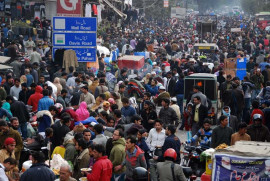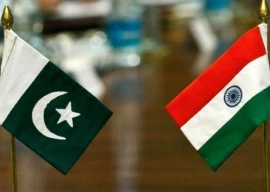
Sadiq Sanjrani is Pakistani politics’ latest fast-food celebrity — prepared instantly, packaged perfectly and served steaming hot to go. In fact, he is more than just the newest Senate chairman, he is now a trending phenomenon; a state-of-play; a whirlpool of endless possibilities; perhaps even a branch of philosophy explaining the joys of instant political gratification.
Oh to be young (40 years) and be a Sanjrani in this day and age!
Make no mistake — something deeply significant is unveiling itself in Islamabad. Were it not so, would it have unleashed a brand new lexicon? Freshly minted lexicology?
“He pulled a Sanjrani on me…” (Translation: He surprised me)
“What the Sanjrani?” (Translation: What on earth…?)
“He’s a right royal Sanjrani” (Translation: He’s a high achiever)
“I have been Sanjranied” (Translation: I have been ambushed)
“I’m in a Sanjrani state-of-mind today” (Translation: I’m feeling lucky)
And so it goes on. And on. The spring offensive belched out a surprise that few were expecting, and fewer still were ready to digest. And yet the mustachioed surprise is now trending as the new shape of things. It seems the Age of Sanjrani has finally dawned.
Who knew how many Sanjranis lurked amongst us? Hiding in plain sight, cloaked in the subdued glory of a mundane existence, salivating at the shimmering eventuality across the next bend, they bide their time well and wait for lady luck to come knocking. They are unburdened by the weight of significance and unencumbered by the sheer lightness of irrelevance. It matters not.
What does matter is the final outcome. Cards are shuffled, chairs are moved, algorithms are reset, priorities are tossed like a leafy green salad and just like that a new reality emerges sporting a waistcoat, a moustache and a wide grin. All is well that ends well.
Except it’s not the end. Sanjrani shadows lengthen by the day as a powerful force stirs yonder.
The battle for Islamabad has already started with skirmishes in the districts and the electoral bloodbath in the Senate. The road to Elections 2018 threatens to be a bumpy and curvy one. Could a Sanjrani be hiding behind every tree and inside every crevice? Cynical calculations breathe life into such predictions.
So Nawaz is jailed, Shehbaz leads the campaign and a group of Sanjranis break free from the party. They could have a wide array of reasons for jumping ship but none as powerful as self-preservation. But enough of them would have to break ranks in order for the PML-N to hurt in the polls. And enough of them may need to be from the PML-N strongholds of central and northern Punjab for the Sanjrani knife to cut close to the party heart.
The Sanjrani option looms large over the PML-N as it limps towards the end of its term.
So Nawaz is jailed, Shehbaz leads the campaign and the PML-N emerges as the single largest party. But it is bruised, battered and truncated. The PTI and PPP romp home with a respectable number of seats and yet are tantalisingly short of the magic figure even if they lock each other in a loving embrace. Sanjrani shadows harken another Sanjrani option for the top slot?
The existence of Sanjranis in our politics is not new — their mainstreaming is. Do remember that Sanjrani is the by-product of a Zardari-Imran arrangement, and that’s as mainstream as you can get. The rebirth of Sanjrani may have been planned by the Establishment but it has been conceived, delivered and registered by two of the three main parties of the country. The Sanjrani option — always looked upon by suspicion by established parties — has now been legitimised as a licensed solution to tricky situations. Dormant Sanjranis are now populating the landscape with relish. They’re in vogue.
But they are not a solution unto themselves. They cannot be because the solution remains a process which is yet to reach an outcome. The mainstreaming of the Sanjrani option is a validation of a hybrid system in which political parties can have a seat at the big table but not the table itself. It marks the end of an era spawned by the so-called Charter of Democracy in which the two main parties had agreed to stand together and reclaim political space from the Establishment. The charter still held up as a bulwark against the PTI dharna of 2014 and enabled the PML-N to ride the storm. But dynamics changed after that with the hounding of Zardari Inc by the Establishment. Self-preservation pushed the PML-N away from the PPP and in the process the charter lost its efficacy. It was every party for itself.
The Sanjrani option — and the way it was engineered — heralds the beginning of a new phase in the politics of Pakistan. This phase is marked by a domineering Establishment, an aggressive Judiciary and a proactive NAB. Together these three institutions are redrawing the rules of governance and accountability without (so far) stepping beyond the confines of the Constitution. Seemingly unconnected events are making patterns which signify some level of synchronisation between institutions. And yet at the wrong end of the stick are not politicians as a whole but one party.
In the Senate, this one party was vanquished by the Sanjrani option. That option now sits on the table biding its time till the general elections. If needed, it will be conveniently copied and pasted onto the National Assembly by a simple feat of engineering brilliance. That’s when it will transform from being the Sanjrani option to becoming the Sanjrani Doctrine.
Not bad for a person who none knew even existed a few weeks ago.
What the Sanjrani!
Published in The Express Tribune, March 18th, 2018.
Like Opinion & Editorial on Facebook, follow @ETOpEd on Twitter to receive all updates on all our daily pieces.



















































COMMENTS (1)
Comments are moderated and generally will be posted if they are on-topic and not abusive.
For more information, please see our Comments FAQ